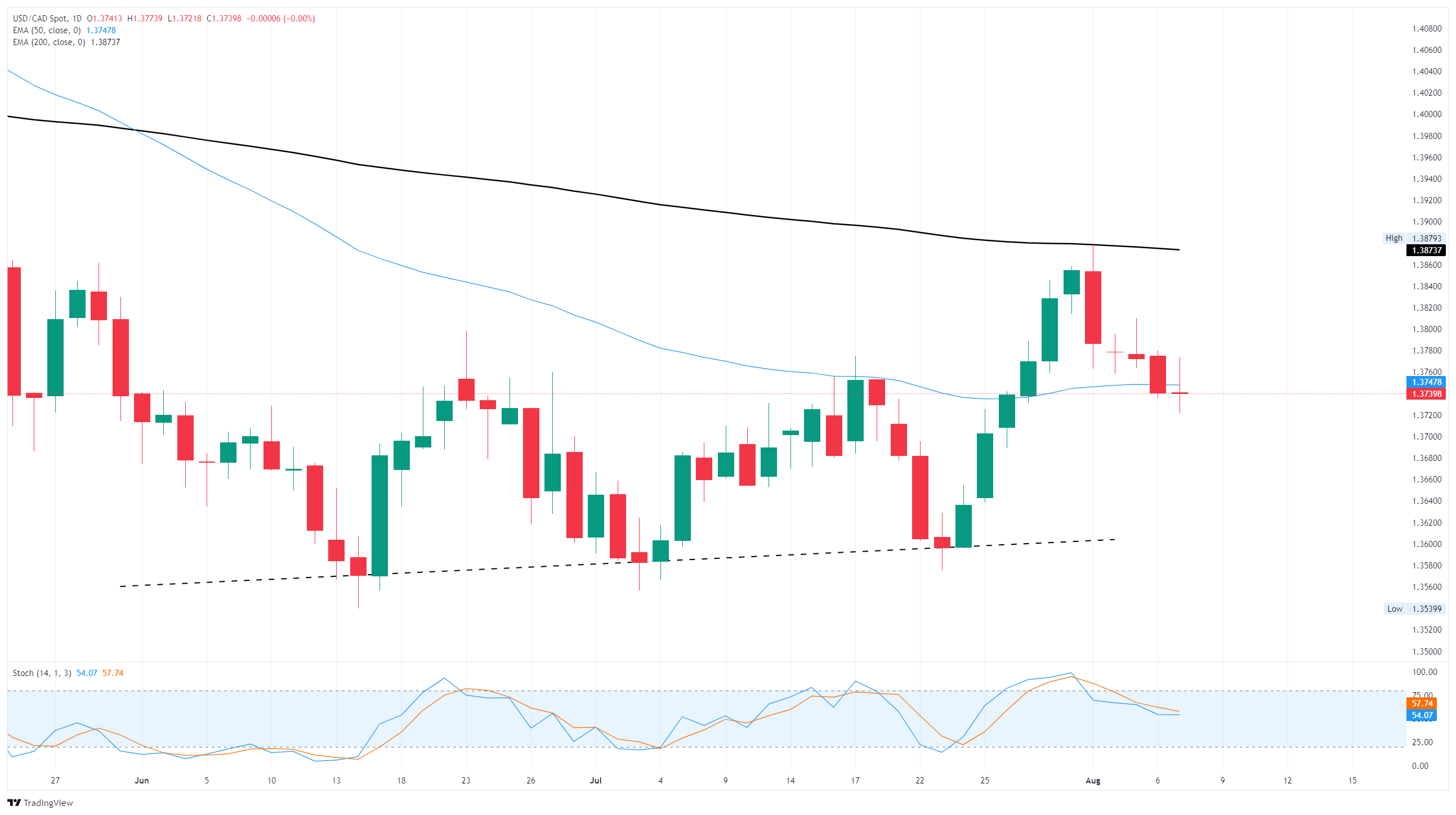
- Canadian Dollar gains have given way to a fresh bounce in US Dollar strength.
- The Loonie snapped a near-term winning streak on Thursday.
- Despite an uptick in Canadian PMI figures, market attention remains focused elsewhere.
The Canadian Dollar (CAD) eased off the gas pedal on Thursday, slowing a near-term bull run and snapping a four-day winning streak against the US Dollar (USD) as Greenback bidding bumped upwards. United States (US) President Donald Trump’s long-awaited “reciprocal” tariffs, initially announced in early April and delayed multiple times, appear to have finally gone into effect.
Mid-tier Canadian Purchasing Managers Index (PMI) figures barely moved the needle on Thursday as markets broadly attempt to shrug off tariff worries. Donald Trump’s whiplash tariff policies, which have been dragged through multiple delays and suspensions over the past five months, have finally kicked off. Double-digit tariff levels are now being applied across the board, on virtually all trading partners with the US, seemingly arbitrarily.
Daily digest market movers: Tariffs have begun, and now markets await the fallout
- The Canadian Dollar is poised to slow its recent bullish momentum against the US Dollar, holding flat on Thursday near 1.3740.
- USD/CAD remains tangled in the 50-day Exponential Moving Average (EMA) as Loonie markets get strung along the middle.
- The Canadian Ivey PMI rose more than expected in July, rising to 55.8 from the previous 53.3 as Canadian businesses dare to hope that the worst of US-Canada trade tensions and tariffs will be avoided.
- Setting aside tariff talk, US Initial Jobless Claims and Unit Labor Costs both rose faster than expected. The mid-tier data releases aren’t immediately market-shifting, but do point toward a hellish mix of unexpected US labor market weakness and ongoing inflationary pressures.
- Inflation from rising labor costs coupled with decaying labor markets, typically known as “stagflation”, is beginning to take bites out of normally solid US economic data, casting a cloud over future US prospects.
Canadian Dollar price forecast
The Canadian Dollar gained ground against the US Dollar in a four-day stretch that bolstered the Loonie over 1% against the Greenback, but CAD momentum looks to be slowing as the USD/CAD chart approaches key technical levels. 1.3700 remains a key technical hurdle as the USD/CAD chart struggles to find momentum below the 50-day EMA at 1.3740, and a pivot into renewed US Dollar strength will send USD/CAD back into a bullish run toward the 200-day EMA near 1.3920.
USD/CAD daily chart

Canadian Dollar FAQs
The key factors driving the Canadian Dollar (CAD) are the level of interest rates set by the Bank of Canada (BoC), the price of Oil, Canada’s largest export, the health of its economy, inflation and the Trade Balance, which is the difference between the value of Canada’s exports versus its imports. Other factors include market sentiment – whether investors are taking on more risky assets (risk-on) or seeking safe-havens (risk-off) – with risk-on being CAD-positive. As its largest trading partner, the health of the US economy is also a key factor influencing the Canadian Dollar.
The Bank of Canada (BoC) has a significant influence on the Canadian Dollar by setting the level of interest rates that banks can lend to one another. This influences the level of interest rates for everyone. The main goal of the BoC is to maintain inflation at 1-3% by adjusting interest rates up or down. Relatively higher interest rates tend to be positive for the CAD. The Bank of Canada can also use quantitative easing and tightening to influence credit conditions, with the former CAD-negative and the latter CAD-positive.
The price of Oil is a key factor impacting the value of the Canadian Dollar. Petroleum is Canada’s biggest export, so Oil price tends to have an immediate impact on the CAD value. Generally, if Oil price rises CAD also goes up, as aggregate demand for the currency increases. The opposite is the case if the price of Oil falls. Higher Oil prices also tend to result in a greater likelihood of a positive Trade Balance, which is also supportive of the CAD.
While inflation had always traditionally been thought of as a negative factor for a currency since it lowers the value of money, the opposite has actually been the case in modern times with the relaxation of cross-border capital controls. Higher inflation tends to lead central banks to put up interest rates which attracts more capital inflows from global investors seeking a lucrative place to keep their money. This increases demand for the local currency, which in Canada’s case is the Canadian Dollar.
Macroeconomic data releases gauge the health of the economy and can have an impact on the Canadian Dollar. Indicators such as GDP, Manufacturing and Services PMIs, employment, and consumer sentiment surveys can all influence the direction of the CAD. A strong economy is good for the Canadian Dollar. Not only does it attract more foreign investment but it may encourage the Bank of Canada to put up interest rates, leading to a stronger currency. If economic data is weak, however, the CAD is likely to fall.
Information on these pages contains forward-looking statements that involve risks and uncertainties. Markets and instruments profiled on this page are for informational purposes only and should not in any way come across as a recommendation to buy or sell in these assets. You should do your own thorough research before making any investment decisions. FXStreet does not in any way guarantee that this information is free from mistakes, errors, or material misstatements. It also does not guarantee that this information is of a timely nature. Investing in Open Markets involves a great deal of risk, including the loss of all or a portion of your investment, as well as emotional distress. All risks, losses and costs associated with investing, including total loss of principal, are your responsibility. The views and opinions expressed in this article are those of the authors and do not necessarily reflect the official policy or position of FXStreet nor its advertisers. The author will not be held responsible for information that is found at the end of links posted on this page.
If not otherwise explicitly mentioned in the body of the article, at the time of writing, the author has no position in any stock mentioned in this article and no business relationship with any company mentioned. The author has not received compensation for writing this article, other than from FXStreet.
FXStreet and the author do not provide personalized recommendations. The author makes no representations as to the accuracy, completeness, or suitability of this information. FXStreet and the author will not be liable for any errors, omissions or any losses, injuries or damages arising from this information and its display or use. Errors and omissions excepted.
The author and FXStreet are not registered investment advisors and nothing in this article is intended to be investment advice.
Editors’ Picks

AUD/USD: Further range bound in store
Despite reaching multi-day highs at 0.6550 during early trading on Thursday, AUD/USD returned to the 0.6500 range against the backdrop of the solid performance of the Greenback. Meanwhile, trade issues continue to dominate mood, as does worry about the Fed’s independence.

EUR/USD: Bullish attempts need conviction
The Greenback gained traction on Thursday, triggering a knee-jerk in EUR/USD after the pair reached multi-day highs near 1.1700 earlier in the day. In the meantime, investors kept a tight eye on US tariffs, while speculation over the probable successor to Fed Chair Powell continued to create a stressful environment.

Gold clings to daily gains near $3,400
Gold resumes its rise on Thursday, approaching the critical $3,400 mark per troy ounce. While markets remain cautious after US President Trump’s tariff threats, mounting prospects for a Russia-Ukraine peace pact seem to be limiting the yellow metal’s positive potential.

Bank of England cuts rates in dramatic meeting
The Bank of England has cut rates by a further 25 basis points to 4% but the statement hints that officials think the easing cycle is nearing its end. Policymakers are visibly worried about a more persistent bout of inflation as the headline number is way higher than target.

Best Brokers for EUR/USD Trading
SPONSORED Discover the top brokers for trading EUR/USD in 2025. Our list features brokers with competitive spreads, fast execution, and powerful platforms. Whether you’re a beginner or an expert, find the right partner to navigate the dynamic Forex market.








